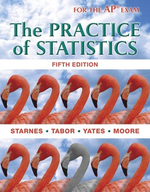Solution Found!
Comparing Stock Returns & Volatility: T-test and F-test Insights
Chapter 10, Problem ap3.35(choose chapter or problem)
An investor is comparing two stocks, A and B. She wants to know if over the long run, there is a significant difference in the return on investment as measured by the percent increase or decrease in the price of the stock from its date of purchase. The investor takes a random sample of 50 annualized daily returns over the past five years for each stock. The data are summarized below.
\(\begin{array}{lcc} \hline \text { Stock } & \text { Mean return } & \text { Standard deviation } \\ \text { A } & 11.8 \% & 12.9 \% \\ \text { B } & 7.1 \% & 9.6 \% \\ \hline \end{array}\)
(a) Is there a significant difference in the mean return on investment for the two stocks? Support your answer with appropriate statistical evidence. Use a 5% significance level.
(b) The investor believes that although the return on investment for Stock A usually exceeds that of Stock B, Stock A represents a riskier investment, where the risk is measured by the price volatility of the stock. The standard deviation is a statistical measure of the price volatility and indicates how much an investment's actual performance during a specified period varies from its average performance over a longer period. Do the price fluctuations in Stock A significantly exceed those of Stock B, as measured by their standard deviations? Identify an appropriate set of hypotheses that the investor is interested in testing.
(c) To measure this, we will construct a test statistic defined as
\(F=\frac{\text { large sample variance }}{\text { smaller sample variance }}\)
What value(s) of the statistic would indicate that the price fluctuations in Stock A significantly exceed those of Stock B? Explain.
(d) Calculate the value of the F statistic using the information given in the table.
(e) Two hundred simulated values of this test statistic, F, were calculated assuming no difference in the standard deviations of the returns for the two stocks. The results of the simulation are displayed in the following dotplot.
Use these simulated values and the test statistic that you calculated in part (d) to determine whether the observed data provide convincing evidence that Stock A is a riskier investment than Stock B. Explain your reasoning.
Questions & Answers
QUESTION:
An investor is comparing two stocks, A and B. She wants to know if over the long run, there is a significant difference in the return on investment as measured by the percent increase or decrease in the price of the stock from its date of purchase. The investor takes a random sample of 50 annualized daily returns over the past five years for each stock. The data are summarized below.
\(\begin{array}{lcc} \hline \text { Stock } & \text { Mean return } & \text { Standard deviation } \\ \text { A } & 11.8 \% & 12.9 \% \\ \text { B } & 7.1 \% & 9.6 \% \\ \hline \end{array}\)
(a) Is there a significant difference in the mean return on investment for the two stocks? Support your answer with appropriate statistical evidence. Use a 5% significance level.
(b) The investor believes that although the return on investment for Stock A usually exceeds that of Stock B, Stock A represents a riskier investment, where the risk is measured by the price volatility of the stock. The standard deviation is a statistical measure of the price volatility and indicates how much an investment's actual performance during a specified period varies from its average performance over a longer period. Do the price fluctuations in Stock A significantly exceed those of Stock B, as measured by their standard deviations? Identify an appropriate set of hypotheses that the investor is interested in testing.
(c) To measure this, we will construct a test statistic defined as
\(F=\frac{\text { large sample variance }}{\text { smaller sample variance }}\)
What value(s) of the statistic would indicate that the price fluctuations in Stock A significantly exceed those of Stock B? Explain.
(d) Calculate the value of the F statistic using the information given in the table.
(e) Two hundred simulated values of this test statistic, F, were calculated assuming no difference in the standard deviations of the returns for the two stocks. The results of the simulation are displayed in the following dotplot.
Use these simulated values and the test statistic that you calculated in part (d) to determine whether the observed data provide convincing evidence that Stock A is a riskier investment than Stock B. Explain your reasoning.
ANSWER:Step 1 of 6
a) We would use four processes to check whether there is a significant difference in the mean return on investment for the two stocks or not.
State:
We want to perform a test at the \(\alpha=0.05\) significance level of \(H_{0}: \mu_{1}-\mu_{2}=0\) versus \(H_{a}: \mu_{1}-\mu_{2} \neq 0\) where \(\mu_{1}\) is the actual mean return for stock A and \(\mu_{2}\) is the actual mean return for stock B.
Plan: We should use a two-sample t-test if the conditions are satisfied.
Random: Investor takes a random sample of 50 daily returns over the past five years for each stock.
Normal: Both samples had 50 observations.
Independent: Due to the random assignment, these two groups of stocks can be viewed as independent. Individual observations in each group should also be independent: knowing the return of one stock gives no information about the return of another stock.
Watch The Answer!
Comparing Stock Returns & Volatility: T-test and F-test Insights
Want To Learn More? To watch the entire video and ALL of the videos in the series:
Compare the mean returns and volatilities of two stocks using t-test and F-test methods. Through the application of hypothesis testing and P-value calculations, we determine which stock provides higher returns and which is riskier.
